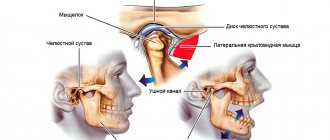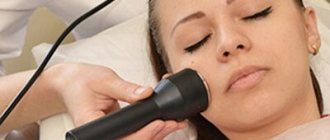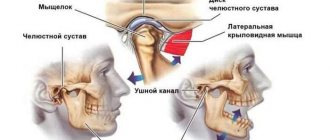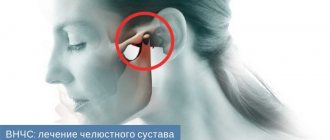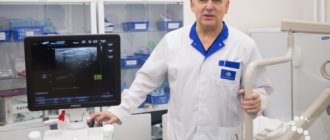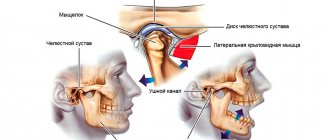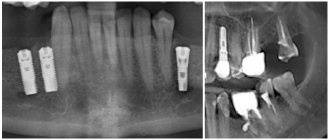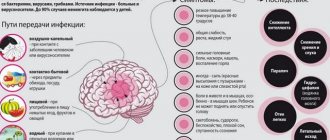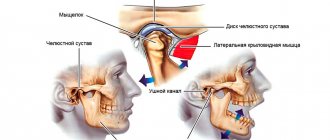Author: Brodsky Sergey Evgenievich Chief physician of the clinic, candidate of medical sciences in the specialties: dentistry and medical microbiology Pain and pathology in the temporomandibular joint have many clinical manifestations and, accordingly, names (Casten syndrome, myofascial syndrome, arthrosis-arthritis of the jaw joints, chronic subluxation of the lower jaw, dysfunction of the TMJ or temporomandibular joint, etc.). Musculo-articular and pain dysfunction of the TMJ has a code according to ICD-10 and belongs to block K00-K14, subparagraph K07.6. Modern gnathological treatment and clinical protocol of this multifactorial disease may require the involvement of several specialists, gnathologist, osteopath, neurologist, physiotherapist, maxillofacial surgeon, orthodontist, dental orthopedist-prosthetist. Where and how to diagnose and properly treat temporomandibular joint dysfunction (TMJ) in Moscow?
- Causes of TMJ dysfunction
- Symptoms and prevention of TMJ dysfunction
- Treatment of TMJ dysfunction
- Center for the treatment of TMJ dysfunction in Moscow
- Cost of treatment for TMJ dysfunction
Structure and function of the mandibular joint
In order to better understand what causes pain and muscle dysfunction of the right and left TMJ joint, it is necessary to understand what it is - the temporomandibular joint, its structure and function.
Mandibular joint (TMJ), photo
In the broadest sense, the structure of the mandibular joint has the following elements and features:
- This is a double, in other words, paired (left and right), combined joint (the only one of its kind in humans).
- The jaw joint belongs to the category of complex joints in the human body, with maximum freedom of movement in different directions. It is divided into two floors (divisions): the upper floor is above the jaw disc, the lower floor is under the disc. The joint is covered by an articular capsule.
- Both joints of the lower jaw normally synchronously reproduce movements in 3 planes:
- horizontal: left - right
- vertical: up-down
- sagittal: back - forward (from back to stomach)
- Between the articular head of the lower jaw and the articular cavity of the skull there is a jaw disc, which covers the middle part of the articular head and serves to soften and absorb pressure in the joint.
- The articular mandibular disc is connected to the internal capsular ligaments, which regulate the movement of the disc forward, backward, left and right. The external ligaments of the joint determine the boundaries of the displacement of the lower jaw, together with the group of masticatory muscles.
- All articular surfaces are covered with cartilage, which secretes synovial fluid to lubricate the jaw joint and improve the sliding of the articular head in the joint.
Treatment
Therapy begins with immobilization of the jaw, as well as with ensuring the rest of the pathological node by applying a sling-shaped bandage. It lasts for several days. Splints to correct the bite or an interdental plate may be applied. A semi-liquid diet is recommended for such patients. Besides:
- Negative symptoms are eliminated by taking non-steroidal drugs, intra-articular injections, and taking antibiotics.
- When fluid with pus accumulates, the cavity of the node is opened and drained. For control, a repeat x-ray of the jaw is prescribed.
- Osteoarthritis requires limiting loads and installing a splint to reduce muscle tone.
- Rheumatoid lesions should be treated with corticosteroids and methotrexate.
- To prevent fusion of surfaces, special physiotherapy, gymnastics, massage, and acupuncture are prescribed.
- If ankylosis develops with immobility, surgical intervention is performed. In rare cases, prosthetics are used.
- Treatment of chronic pain is achieved through complex therapy. The patient is examined by a dentist, neurologist, psychotherapist, and physiotherapist.
- To unload the joint, wearing a mouth guard is practiced.
Complete cure occurs after eliminating all provoking factors.
Causes of TMJ dysfunction
Conventionally, we can distinguish 3 main reasons for the development and etiology of the clinic of TMJ jaw joint dysfunction:
- Imbalance and disruption of the nervous coordination of the jaw muscles that raise and lower the lower jaw. Most often, the tone and tension of the muscle fibers in the right and left masticatory muscles are first disturbed, and then their imbalance occurs, irritation of the bilaminar zone and pain when chewing and swallowing.
- Chronic stress, over a long period of time (from a year or more), caused by a disorder of the central nervous system and higher nervous activity.
- Malocclusion and occlusion (closing) of teeth, coupled with non-standard sizes and position of the jaws relative to each other and the base of the skull.
As a rule, all of the above factors, to a greater or lesser extent, occur if a diagnosis of TMJ dysfunction syndrome is made. Reviews from patients and a forum on the Internet confirm this.
A hereditary predisposition to dysfunction of the jaw joints has been proven, with genetic anomalies associated with malocclusion, especially with micrognathia and macrognathia of the lower or upper jaw.
Risk factors
A number of reasons can lead to the development of arthritis of the jaw.
Violation of the structure occurs due to the following reasons:
- traumatic factor. The cause in this case may be a blow, a fracture, or a sudden opening of the mouth;
- infectious diseases of the ENT organs or lower jaw. Arthritis of the maxillary joint is caused by streptococci, chlamydia, mycobacterium tuberculosis, and various viruses;
- osteomyelitis;
- untreated caries or periodontitis;
- otitis, mumps. Arthritis is a complication of these pathologies;
- gout;
- reactive arthritis;
- systemic lupus erythematosus;
- metabolic disorders;
- diabetes;
- thyroid diseases;
- rheumatoid arthritis.
Sometimes inflammation is a consequence of hypothermia.
Symptoms and prevention of TMJ dysfunction
At the PartnerMed dental clinic, diagnosis of TMJ dysfunction is carried out by a gnathologist. He also draws up a treatment plan. When making a diagnosis, the following symptoms are taken into account:
- Pain in the jaw joints
- As a rule, with TMJ dysfunction, chronic pain occurs in the temporal, trapezius, chewing and a number of other muscles. Dull or aching dental, eye, headache and facial pain appears, and trigeminal neuralgia syndrome may develop, which forces differential diagnosis with arthritis and osteochondrosis of the cervical spine, as well as otitis media.
- Difficulty opening the mouth
- There is a kind of blocking of movements or jamming in the TMJ. In order to open your mouth, you must first move your jaw slightly to the left, right, forward or backward.
- Clicking in the jaw
- At the moment of opening the mouth, chewing and yawning, clicks and crunching occur in the TMJ joint. Other noises are also possible in the form of grinding, popping, sometimes loud enough to be heard by strangers.
In addition, depending on the dominance of various causes during the development of the disease, there may be difficulties in swallowing food, pain in the tongue, ringing and noise in the ears, dry mouth, changes in the sensitivity of the lips, palate and other pathological manifestations.
In order to make a complete and final diagnosis of TMJ dysfunction, the following clinical examinations are carried out as prescribed by a gnathologist:
- CT and MRI of joints (it is most advisable to do a dynamic MRI of the TMJ)
- Blood tests, including rheumatoid factor, allergy status, extended immunogram
- Consultation with a gnathologist and an osteopathic dentist (or an osteopath working together with a dentist)
- Functional diagnostics of dentition (taking into account lateral and frontal separation of teeth)
- Diagnostics of tooth models in an articulator
- MPI analysis (finding the correct position of the lower jaw)
- Electromyography
- Electronic axiography and condylography
Request a call back or dial our number!
+7
This phone call does not obligate you to anything. Just give us a chance and we will help you!
Proper prevention of TMJ jaw joint dysfunction requires timely getting rid of bad habits, chewing gum, and frequent consumption of very hard foods, such as chewing dried squid and fish with beer. When engaging in professional sports such as boxing, wrestling, and mixfight, be sure to use protective equipment, helmets, and protective mouthguards. It is necessary to regularly consult a gnathologist for the treatment of bruxism, jaw clicking and other gnathological diseases.
TMJ dysfunction, photo
Clinical picture (symptoms)
Arthritis is accompanied by pain and discomfort.
The disease manifests itself in the following characteristic symptoms:
- pain in the jaw area, which radiates to other parts of the face and intensifies with movements and opening the mouth;
- dizziness;
- sleep disorders;
- limited movement in the joint;
- feverish condition;
- inflammation of the skin and soft tissues around the joints;
- elevated temperature;
- clicking in the jaw area when it moves;
- temperature rise up to 38 degrees, sometimes higher;
- pain when palpating the affected area (joint pain);
- deformation of the contours of the face due to the fact that the chin “goes” to the side;
- feeling of weakness, increased fatigue;
- hearing impairment.
Important! With arthritis of the jaw joint there is a risk of the formation of purulent inflammation. In this case, the joint swells and the skin becomes red and hypersensitive. A lump is felt in the area of the mandibular joint. The shade of the skin changes, speech and chewing functions are impaired.
Treatment of TMJ dysfunction
Effective and modern methods of treating TMJ dysfunction involve an interdisciplinary approach. This means that medications, speech limitation, physiotherapy, osteopathy, exercise therapy, myogymnastics, splints and distraction mouthguards for the lower jaw, orthopedic and orthodontic structures are selected by a single team consisting of doctors of different specialties, gnathologists, osteopaths, neurologists, psychologists, orthodontists and others specialists. Methods and methods for treating TMJ dysfunction in Moscow, St. Petersburg and other large Russian cities are not fundamentally different from each other and have a common algorithm.
Depending on the predominance of one or another etiological factor, emphasis may be placed to a greater or lesser extent on different methods of treating jaw joint dysfunction. However, the same algorithm and clinical protocols exist for the treatment of chronic TMJ dysfunction.
Standard treatment regimen for TMJ
- Relief of pain in the TMJ using a distraction cap and analgesics;
- Carrying out physiotherapy and drug complex therapy to relieve intra-articular inflammation;
- Normalization of masticatory muscle tone using splint therapy (and possibly Botox);
- Determination of the correct constructive occlusion of the oral cavity;
- Temporary prosthetics of the oral cavity using a silicone key for constructive occlusion;
- Final prosthetics with fixed dentures.
Treatment of TMJ, photo.
Treatment options
Pathology is treated in the following ways:
- Fixation
fixation . The first thing that is done when arthritis of the jaw joint is diagnosed is to ensure the immobility of the affected structure. To do this, apply a bandage. On the side of the diseased joint, between the teeth, a special plate is placed, which should remain there for 2-3 days;
- taking medications . The patient is prescribed analgesics to suppress pain and reduce temperature (Nurofen, Analgin), antibacterial drugs (Tetracycline, Amoxicillin), non-steroidal anti-inflammatory drugs (Celecoxib, Nimesulide). Immunosuppressants may be prescribed, which is required for rheumatoid arthritis. The group of such drugs includes Etanercept, Leflunomide;
- drug blockade . The goal of therapy is to relieve pain in the affected joint. Novocaine injections may be prescribed;
- ointments, compresses . For pain in the affected joint, topical agents are prescribed, for example, ointments containing bee or snake venom. Ointments, by heating the affected area, restore joint mobility and suppress muscle spasms;
- sanitation of the oral cavity . This method is required for rheumatoid arthritis.
Drug blockade
Exercise is another way to restore the mobility of an inflamed joint at home. The specialist prescribes a course of therapeutic exercises for the patient. The most effective and common exercise is to open the mouth using only the upper part of the jaw.
Physiotherapy helps with TMJ arthritis. Effective measures include:
- magnetic therapy;
- laser therapy;
- mud therapy;
- ultrasound therapy;
- cryotherapy.
Therapeutic massage sessions are also available .
Surgical intervention is carried out in case of development of a purulent process, rupture of the joint capsule, fractures of the articular surfaces. During the operation, the specialist installs a drainage system.
Traditional methods of treatment include the following:
- cabbage leaf compress . You need to take one sheet, iron it with a heated iron, and apply it to the affected area. Carry out the procedure 1-2 times a day;
- compress with sea salt . It is necessary to calcinate natural sea salt in a frying pan, then wrap it in a piece of linen cloth. Apply to the affected area. Repeat application up to two times a day;
- infusion of yarrow . Pour 4 tablespoons of raw material into 400 ml of boiling water. The product should sit for 2 hours. You need to take it 4 times a day, 50 ml each time.
The condition must be corrected with the help of a doctor.
Center for the treatment of TMJ dysfunction in Moscow
Today, clinics and treatment centers for TMJ dysfunction in Moscow, various forums and patient reviews make it possible to determine the gold standard of effective treatment methods and related equipment that most effectively treats this disease.
The list of necessary diagnostic and treatment equipment used by leading specialized institutions, including the Partner Med clinic, includes:
- Articulators and facebows "Girbach"
- Axiograph "Gamma"
- "Mist Tens" device
- Computer electromyograph "Synapsis"
- Fox osteopathic apparatus
- Computer occlusion analyzers “T-scan”
and some other devices.
The course for the treatment of TMJ dysfunction at the Partner Med dental clinic lasts from 3 to 12 months, depending on the complexity and number of necessary diagnostic and treatment procedures in each specific clinical case.
Prevention
To minimize the risk of developing a pathological process, it is recommended to follow the following rules:
- promptly treat diseases in which the formation of purulent foci occurs;
- protect yourself from traumatic factors;
- avoid hypothermia;
- promptly treat nasopharyngeal pathologies;
- treat acute infectious processes;
- eliminate dental problems.
To prevent the pathological process from worsening, it is important to seek help from a medical facility as quickly as possible.
Advantages of the TMJ Treatment Center Partner-Med
Experience at least 5 years
Only doctors with 8-30 years of experience practice at the Partner-Med clinic
15 year labor guarantee
Only a qualified dentist gives an extended guarantee of up to 15 years on his work.
Study abroad
Our doctors annually improve their qualifications in specialized clinics in Europe.
Chief Physician, Dmitry Nikolaevich Salatsky
Sign up for a gnathological consultation
+7
What is TMJ arthritis?
Arthritis is an inflammation of the structural elements of a joint. The disease leads to impaired motor function of the affected joint and is accompanied by a number of specific symptoms that require attention.
TMJ arthritis is diagnosed in approximately 15% of cases of joint diseases. This prevalence of pathology is associated with the characteristics of the load to which this joint is exposed daily.
The inflammatory process in arthritis begins with the joint capsule and the tissues around them. The disease progresses slowly, gradually affecting the synovium of the joint. Over time, bone tissue is also involved in the inflammatory process, which leads to deformation of the joint and disruption of its functions. In advanced cases, cartilage tissue is destroyed and connective tissue is formed directly in the cavity of the affected joint. This is the most unfavorable prognosis for arthritis, since such changes entail severe impairment of the motor function of the temporomandibular joint. This can lead to severe contracture, joint deformation, and immobility of the lower jaw.
Cost of treatment for TMJ dysfunction
Answering questions frequently asked by patients: “How much does treatment for TMJ dysfunction cost, with a discount, at a promotion? Where and how much cheaper are the prices for such turnkey treatment, in Moscow, St. Petersburg or other cities of Russia?”, it should be noted that the price of treatment for pathology and dysfunction of the TMJ jaw joints and the cost of its individual stages depends on the following points:
The cost of diagnosing TMJ dysfunction starts from 10,000 rubles and can reach 80,000 rubles or more. The price of treatment starts from 15,000 rubles and can reach 300,000 rubles or more.
- From the complexity of diagnosis and the number of medical procedures
- From the qualifications of gnathologists, orthodontists and other specialists
- From the pricing policy of each specific dental center
Just pick up the phone and call us!
8
We will definitely make you an offer that you cannot refuse!
Methods for diagnosing arthritis of the jaw joint
Arthritis on x-ray
Diagnosis and treatment of the inflammatory process in the jaw joint area can be carried out by different specialists, which depends on the cause that caused its development. This could be an ENT doctor, a dentist, a traumatologist, an infectious disease specialist, or a dermatovenerologist.
The main diagnostic measures include:
- radiography . During this diagnostic exercise, widening or narrowing of the joint space is detected, which indicates acute or chronic arthritis of the TMJ, respectively;
- magnetic resonance imaging . The method allows you to study the condition of soft tissues, estimate the amount of fluid in the joint cavity;
- CT scan . This method of research makes it possible to differentiate between healthy and damaged tissues;
- ultrasound diagnostics . Using this research method, it is possible to visualize the fluid in the joint cavity. However, it is impossible to fully study the structure of soft tissues in this way.
Note! Acute arthritis of the TMJ is differentiated from such pathologies as acute otitis media, trigeminal neuralgia, gout.
After obtaining the necessary data and making a diagnosis, an individual course of treatment is developed.
Prevention and prognosis
Symptoms of inflammation in TMJ arthritis appear quite quickly, the disease progresses rapidly, so the prognosis depends on how quickly the disease is detected and treatment is started. Timely adequate therapy will allow you to completely get rid of the disease in 2-3 weeks. At the same time, TMJ arthritis almost never develops again. Treatment of a chronic disease will take about 1-1.5 months, taking into account a long course of physiotherapy.
There is no specific prevention for TMJ arthritis. It comes down to being attentive to your own well-being and timely treatment of any infectious diseases. It is important to prevent the presence of chronic foci of infection in the body, especially in the oral cavity.
Related Articles
Osteoporosis of the jaw: causes, symptoms and methods of treating pathology
How is arthritis determined according to ICD-10: codes for different types of disease
Arthrosis-arthritis of the knee joint: features of the disease and treatment methods
Undifferentiated arthritis: features of the disease, causes of development, ICD-10 code and treatment
Synovitis of the knee joint: causes of development, ICD-10 code, symptoms and treatment
Arthrosis-arthritis of the hip joint: ICD-10 code, treatment methods, therapeutic exercises
Reasons for the development of the disease
Arthritis of the temporomandibular joint is a severe inflammatory disease
The exact causes of the development of arthritis of the mandibular joint have not yet been established. This form of pathology rarely appears as part of the symptom complex of rheumatoid arthritis due to the specific structure of the joint, while rheumatoid arthritis primarily affects small joints of the extremities.
Arthritis of the temporomandibular joint was assigned the ICD-10 code K07.6. Thus, the international classification of diseases ICD-10 classifies arthritis of the temporomandibular joint as a group of maxillofacial pathologies, but not as a joint disease.
If the trigeminal nerve and lower jaw are affected, TMJ arthritis according to ICD-10 may have a different code - G50. With degenerative-dystrophic changes in cartilage tissue, this pathology is assigned code M19.8 in ICD-10 protocols.
Conventionally, the causes of the development of the disease can be classified into three groups:
- infectious;
- non-infectious;
- specific.
Infectious causes are the penetration of pathogenic agents into the capsule of the temporomandibular joint. Infection occurs against the background of infection with tuberculosis, syphilis, and gonorrhea. Infectious causes may also include the measles virus. Often arthritis is a consequence of serious illnesses, for example, a recent flu that was treated incorrectly.
Infectious arthritis of the TMJ can develop against the background of dental and otolaryngological diseases. In this case, the infection penetrates the joint by hematogenous or contact route. The cause of infection of the joint can be advanced caries, acute otitis media of the middle ear, abscess of the ear canal .
Non-infectious arthritis develops as a result of injuries and bruises. They are a consequence of the lack of necessary treatment for fractures and injuries of the jaw.
Specific arthritis is a disease that develops against the background of another chronic pathology. They may be associated with damage to the facial nerves, as a result of which the functioning of the joints is impaired. TMJ arthritis may be part of the symptom complex of systemic lupus erythematosus or other autoimmune disorders.
In fairness, it should be clarified that damage to the temporomandibular joint against the background of systemic connective tissue diseases is very rare; most often the complication spreads to the small joints of the lower and upper extremities.
Classification of arthritis
TMJ arthritis is a nonspecific disease, despite its widespread occurrence. The forms and types of the disease are classified according to the nature of development and the nature of the course of the pathology.
Due to their development, the following types of arthritis are distinguished:
- infectious,
- non-infectious,
- traumatic.
Infectious arthritis, in turn, is divided into contact and hematogenous. Contact arthritis develops due to the penetration of pathogenic microorganisms into the joint against the background of infection of organs located in close proximity to the TMJ. Hematogenous arthritis is a consequence of the spread of infection in an ascending direction through the bloodstream. This form of the disease develops in tuberculosis, measles, syphilis, and other severe bacterial pathologies.
The cause of the development of traumatic arthritis of the TMJ are injuries, bruises, fractures, and tendon compression. This form of the disease can occur after severe road accidents or in athletes who have injured their jaw.
Read also: Osteoporosis drug may prevent fractures in older women
Non-infectious arthritis can be traumatic, rheumatoid (autoimmune) or reactive. Reactive arthritis develops against the background of existing infectious diseases, but no pathogenic microorganisms are found in the synovium of the joint.
Separately, dystrophic arthritis is distinguished, which is a consequence of disruption of local metabolic processes. In this case, there is a lack of nutrition of the cartilage tissue, its gradual degeneration and loss of elasticity of the cartilage.
According to the nature of the course, the inflammatory disease is divided into chronic and acute. Acute TMJ arthritis is characterized by pronounced symptoms and a general deterioration in well-being. The disease may be accompanied by suppuration in the joint capsule and infection of the periarticular tissues. Chronic TMJ arthritis is characterized by moderate severity of symptoms, but with periodic exacerbations.
In the absence of adequate therapy, acute arthritis can become chronic, which is difficult to treat.
With arthritis of the temporomandibular joint, symptoms depend on the type of inflammatory reaction and the form of the disease. Regardless of the cause of TMJ arthritis, the symptoms require attention, so you should consult a doctor if you experience the slightest discomfort in the jaw, since the advanced form of the disease is difficult to cure.
